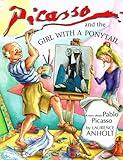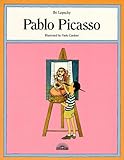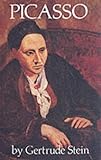|
|
Help |
| Home - Artists - Picasso Pablo (Books) | |
e99 Online Shopping Mall
|
|
Help |
| Home - Artists - Picasso Pablo (Books) | |
| Back | 61-80 of 100 | Next 20 |
click price to see details click image to enlarge click link to go to the store
| 61. Picasso: Toros y toreros : Paris, Musee Picasso, 6 avril-28 juin 1993, Bayonne, Musee Bonnat, 9 juillet-13 septembre 1993, Barcelone, Museu Picasso, 6 octobre 1993-9 janvier 1994 (French Edition) by Pablo Picasso | |
| Paperback: 255
Pages
(1993)
Isbn: 2711826961 Canada | United Kingdom | Germany | France | Japan | |
| 62. Picasso: The Monograph, 1881-1973 by Pablo Picasso | |
 | Paperback: 552
Pages
(2009-07-31)
list price: US$49.00 -- used & new: US$30.64 (price subject to change: see help) Asin: 8434310910 Canada | United Kingdom | Germany | France | Japan |
|
Editorial Review Product Description | |
| 63. Einstein, Picasso: Space, Time, and the Beauty That Causes Havoc by Arthur I. Miller | |
 | Paperback: 368
Pages
(2002-03)
list price: US$17.00 -- used & new: US$7.94 (price subject to change: see help) Asin: 0465018602 Average Customer Review: Canada | United Kingdom | Germany | France | Japan |
|
Editorial Review Product Description The most important scientist of the twentieth century and the most important artist had their periods of greatest creativity almost simultaneously and in remarkably similar circumstances. This fascinating parallel biography of Albert Einstein and Pablo Picasso as young men examines their greatest creations--Picasso's Les Demoiselles d'Avignon and Einstein's special theory of relativity. Miller shows how these breakthroughs arose not only from within their respective fields but from larger currents in the intellectual culture of the times. Ultimately, Miller shows how Einstein and Picasso, in a deep and important sense, were both working on the same problem. Customer Reviews (12)
This dual biography centers on the special relativity theory discovered by Einstein in 1905 and the Cubism painting "Les Demoiselles d'Avignon" produced by Picasso in 1907. In the first chapter, the author mentions that Poincare's book "La Science et l'hypothese" gave a spur to both of the two geniuses and led them to explore new notions of space and time. Tracing their respective lives in later chapters, the author clarifies how both men sought representations of nature that transcend those of classical thought and reach beyond appearances. The reader would be convinced of the fact that the effect of Poincare's book is not a superficial similarity between the works of Einstein and Picasso but a common denominator deeply rooted in the culture and science of the early twentieth century. In the last chapter the author insists that at the creative moment boundaries between disciplines dissolve. Namely, aesthetics becomes paramount also in science; on the other hand, artists solve problems just like scientists. So, if you are a scientist, you would find direct interest in the chapters on Einstein and also find it profitable to read the chapters on Picasso; and if you are an artist, the reverse would be true. Laypersons would also get a lot of stimuli to a productive life from this book. ... Read more | |
| 64. Picasso Looks at Degas (Sterling & Francine Clark Art Institute) by Elizabeth Cowling, Mr. Richard Kendall, Montse Torras | |
 | Hardcover: 368
Pages
(2010-07-13)
list price: US$65.00 -- used & new: US$40.94 (price subject to change: see help) Asin: 0300134126 Average Customer Review: Canada | United Kingdom | Germany | France | Japan |
|
Editorial Review Product Description The great Spanish painter and sculptor Pablo Picasso (1881-1973) exhibited a lifelong fascinationsome might say obsession”with the work and personality of French artist Edgar Degas (1834-1917). In this groundbreaking study, noted Degas scholar Richard Kendall and Picasso expert Elizabeth Cowling present well-documented instances of Picasso’s direct responses to Degas’s work, as well as more conceptual and challenging affinities between their oeuvres. Richly illustrated essays explore the artists’ parallel interests in modern urban life, ballet dancers, activities such as bathing and combing the hair, photography, and the challenges of sculpture. The book also provides the first extended analysis of Picasso’s engagement with Degas’s art in his final years, when he acquired several of the French artist’s brothel monotypes and reworked some of them in his own prints. Offering many fresh ideas and a significant amount of new material about two of the most popular and influential artists of the modern era, this handsome book promises to make a lasting contribution to the literature on both artists. Customer Reviews (2)
| |
| 65. Toros by Pablo Picasso | |
| Unknown Binding:
Pages
(1999-01-01)
Asin: B003XKC5RK Canada | United Kingdom | Germany | France | Japan | |
| 66. Picasso Mosqueteros: The Late Works 1962-1972 | |
 | Hardcover: 300
Pages
(2009-04-22)
list price: US$100.00 -- used & new: US$235.94 (price subject to change: see help) Asin: 0847832996 Average Customer Review: Canada | United Kingdom | Germany | France | Japan |
|
Editorial Review Product Description Customer Reviews (3)
| |
| 67. Picasso Erotique (Art & Design) by Pablo Picasso | |
 | Hardcover: 365
Pages
(2001-06-14)
list price: US$70.00 -- used & new: US$179.98 (price subject to change: see help) Asin: 3791325612 Average Customer Review: Canada | United Kingdom | Germany | France | Japan |
|
Editorial Review Product Description Customer Reviews (2)
Clair's own "The School of Darkness" is a heady and passionate appreciation of Picasso. He contributes right off to the decades-old debate regarding Picasso's view and treatment of women. He defends the artist and the man,rejecting portrayals of Picasso as " the ogre, the dark demon, the wife-eating Minotaur," quoting writer Micheline Sauvage's words on Don Juan: "Not the profaner of love, but the hero of profane love." Picasso possessed energy and drive that included prodigious eating, drinking, sexual expression, writing, the production of art, and more art. Housekeeping out of the way, Clair'sessay grows into something remarkable: part biography, part chant. If you read it aloud you might well amaze and delight yourself and your listener. Annie Le Brun's "Painting in the Bedroom" successfully places Picasso's erotic sensibilities and drivein context and in comparison to other painters, whom she asserts (and proves) shared traits with Picasso. 'Diamond Made of All the Love of the Loves of Blood,' (the title comes from a diary entry ofthe artist) by Marie-Noelle Delorme is a fabulous compilation, effectively and subtlely organized, that shows Picasso the energetic and larger-than-life diarist - a passionate and powerful writer on love, bodies, intimate landscapes, and much more. The illustrations - a "Chronological Catalogue of Exhibited Works,"fill over 200 pages. The layout and the colors are good and the plates are big enough. There are oil paintings, etchings, drawings in pencil, colored pencil, chalk, ink, and charcoal;aquatint, drypoint, etchings; sculptures in wood, plaster, clay and bronze - and more. The earliest drawing is a copulation scene, "Donkey and She-Ass," done by a nine-year old Picasso - who as a schoolboy was already drawing confidently and well and, it can be argued, had already found his voice. The works are of men, women, animals together, animals with people, blind men, lovers, voyeurs, brothel scenes, outsized genitalia,mythological beasts and people, nudes in classical poses, Cubist paintings on erotic themes, sketches of solicitude and tenderness and caring, playfully altered pin-ups from the 50's, visions of sexuality altered but undimmed by old age, and much more. By virtue of its twelve strong, smart, passionate essays, and its 300 plates,thisbook becomes much more than the sum of its parts.Very worthwhile, and a great read. ... Read more | |
| 68. Picasso and the Girl with a Ponytail by Laurence Anholt | |
 | Hardcover: 32
Pages
(1998-09-01)
list price: US$14.95 -- used & new: US$8.01 (price subject to change: see help) Asin: 0764150316 Average Customer Review: Canada | United Kingdom | Germany | France | Japan |
|
Editorial Review Product Description Author and illustrator, Laurence Anholt, captures the spirit of this warm-hearted story in words and pictures. In the process he also introduces several of Picasso's most famous paintings. Young readers will be intrigued to see how Picasso transformed Sylvette's image into a variety of fantastic and whimsical forms. (Ages 4-7). Customer Reviews (12)
| |
| 69. Picasso's Mask by Andre Malraux | |
 | Paperback: 288
Pages
(1995-03-22)
list price: US$14.95 -- used & new: US$7.80 (price subject to change: see help) Asin: 0306806290 Average Customer Review: Canada | United Kingdom | Germany | France | Japan |
|
Editorial Review Product Description Customer Reviews (1)
| |
| 70. Picasso Museum, Paris, the: Painting, Papier Colles, Picture Reliefs, Sculptures, Ceramics by Marie-Laure Bernadac, Michele Richet, Marie-Laure Besnard-Bernadac, Pablo Picasso, Helene Seckel-Klein, France) Musee Picasso (Paris | |
| Hardcover: 315
Pages
(1989-03)
list price: US$49.50 -- used & new: US$95.00 (price subject to change: see help) Asin: 0810914891 Canada | United Kingdom | Germany | France | Japan | |
| 71. Pablo Picasso (Famous People Series) by Ibi Lepscky | |
 | Paperback:
Pages
(1993-03)
list price: US$6.95 -- used & new: US$73.55 (price subject to change: see help) Asin: 0812014502 Average Customer Review: Canada | United Kingdom | Germany | France | Japan |
|
Editorial Review Product Description Customer Reviews (1)
| |
| 72. Goodbye Picasso by David Douglas Duncan | |
| Hardcover: 299
Pages
(1974)
Isbn: 0448116197 Canada | United Kingdom | Germany | France | Japan | |
| 73. PABLO PICASSO: A Retrospective. Edited by William S. Rubin. Chronology by Jane Fluegel. May-Sept. 1980. by New York. The Museum of Modern Art. | |
| Paperback:
Pages
(1980)
Asin: B0040Z9VQ0 Canada | United Kingdom | Germany | France | Japan | |
| 74. Pablo Picasso (Art for Children) by Ernest Lloyd Raboff | |
| Paperback:
Pages
(1987-09)
list price: US$7.95 -- used & new: US$7.25 (price subject to change: see help) Asin: 0064460673 Canada | United Kingdom | Germany | France | Japan | |
|
Editorial Review Product Description | |
| 75. Picasso's Women: Eight Monologues (Oberon Books) by Brian McAvera | |
 | Paperback: 144
Pages
(1998-08-01)
list price: US$26.95 -- used & new: US$22.94 (price subject to change: see help) Asin: 1870259866 Average Customer Review: Canada | United Kingdom | Germany | France | Japan |
|
Editorial Review Product Description Customer Reviews (1)
| |
| 76. Pablo Picasso (Genius! Series) by Robin Langley-sommer | |
| Hardcover: 128
Pages
(1990-05)
list price: US$7.95 -- used & new: US$2.21 (price subject to change: see help) Asin: 0382240316 Canada | United Kingdom | Germany | France | Japan | |
|
Editorial Review Product Description | |
| 77. Picasso's Brothel: Les Demoiselles d'Avignon by Wayne Andersen | |
 | Paperback: 368
Pages
(2002-03-07)
list price: US$25.00 -- used & new: US$22.47 (price subject to change: see help) Asin: 1892746921 Average Customer Review: Canada | United Kingdom | Germany | France | Japan |
|
Editorial Review Product Description Customer Reviews (1)
| |
| 78. Picasso by Gertrude Stein | |
 | Paperback: 128
Pages
(1984-09-01)
list price: US$6.95 -- used & new: US$3.61 (price subject to change: see help) Asin: 0486247155 Average Customer Review: Canada | United Kingdom | Germany | France | Japan |
|
Editorial Review Product Description Customer Reviews (5)
Stein says with characteristic self assurance that she alone understood Picasso and compared what he did in art to what she did with words, and there is merit in the comparison.Picasso, influenced by the Spaniards, came to believe that truth existed in the conceptual realm, it did not come from the material world.Whereas proceeding generations accepted what they saw before them as truth and responded realistically, Picasso chose to portray his inner vision on canvas and backed away from using models.Cubism became his way of signifying how he experienced the significance of the still life or human form.A person, a tableau was not perceived as the whole but as parts, some of them standing out more prominently than others.Similarly, Stein orders her information according to emphasis, with her characteristic tic of repetition--remember, this is the person who gave us lines like "A rose is a rose is a rose" and "there is no there, there." Stein does not overindulge herself, however, and imparts a generous amount of lucid thought on how Picasso created and from what and whom he drew his influences.She progresses chronologically through his periods-the blue, the rose, the harlequin, Cubist, calligraphic, etc., up to the point she was writing. This plus salient insights into society, war, creative artists and the 20th century in general make the volume quite a deal in a small package.
Stein's fame comes more from her position in theintellectual and artistic community of early to mid twentieth century Paristhan from her ability as a writer or poet.It was because of this positionthat she came to know Picasso so well, and it was as an outgrowth of thispersonal relationship that this book came to be written. One area that Ifound very informative in PICASSO was Stein's analysis of the alternatinginfluences of Picasso's Spanish soul, Paris, and Spain itself, on thevarious periods of Picasso's artistic development.In this respect, Steincontrasts Spain and France in the following manner:Spain was a sadcountry with a monotony of coloring while France was the country ofToulouse-Lautrec with vivid colors and images. With that as a background,she introduced Picasso, as a young man in Spain, painting realistic worksin the late nineteenth century manner.This was followed by his firstvisit to Paris during which he was influenced by the paintings ofToulouse-Lautrec.(See illustration #3, "In the Cafe")He thenreturned to Spain in 1902, staying until 1904.During this period, histemperament returned to that of his native Spain and he produced thedarker, more somber paintings of his "blue period."This periodended with his return to Paris in 1904.Throughout the balance of PICASSO,Stein traced his painting cycles and the people and experiences thatinfluenced them. Picasso revealed to Stein, and she passed on to us, oneof the main secrets of his later styles.He saw as a very young child saw,and painted what he saw through those infantile eyes.An infant sees whatit sees from very close up and, consequently, only sees one or two of itsmother's features at a time.An infant can't focus at a distance andprobably couldn't recognize its own mother from across a room.That infantwould probably recognize an eye or a nose, or one or two other features. That same child would probably only recognize its mother in profile, andonly from one side at that, i.e., left or right profile, but not both. This was the vision that Picasso brought to his art:a recognizable eye, anose in profile, and these not necessarily connected in any way that makessense to the eye of an adult viewer.It was one of the geniuses of Picassothat he could utilize this vision in his art, and it was as a gift thatGertrude Stein let us in on the secret. I have visited the Picassomuseums in Barcelona and Paris, and through their displays, have tracedPicasso's evolution as an artist.Neither museum was as instructiverelative to Picasso's thought processes as was this small book with itsmany black and white illustrations.For having providing these insights, Ican forgive Gertrude Stein for all her mannerisms and displays ofego. Much more information about Picasso and the literary and artisticpersonages of his era can be gained by reading this book.I do recommendit.
| |
| 79. Picasso & The Weeping Women by Rizzoli | |
 | Hardcover: 215
Pages
(1994-03-15)
list price: US$50.00 -- used & new: US$17.99 (price subject to change: see help) Asin: 0847818004 Average Customer Review: Canada | United Kingdom | Germany | France | Japan |
|
Editorial Review Product Description Customer Reviews (4)
| |
| 80. A Picasso Anthology | |
 | Paperback: 288
Pages
(1997-04-01)
list price: US$29.95 -- used & new: US$17.37 (price subject to change: see help) Asin: 0691003483 Canada | United Kingdom | Germany | France | Japan |
|
Editorial Review Product Description A Picasso Anthology contains a wide range and variety of contemporary responses to Picasso and his art. There are essential passages from books by his close friends, including Apollinaire, Cocteau, and Roland Penrose; an important body of Catalan and Spanish criticism; reactions from English critics, including Roger Fry and John Middleton; a remarkable collection of Russian criticism of his cubist work, written in the years just before the Revolution; and Czech, Danish, and Italian articles, as well as mainstream texts from France and Germany. | |
| Back | 61-80 of 100 | Next 20 |